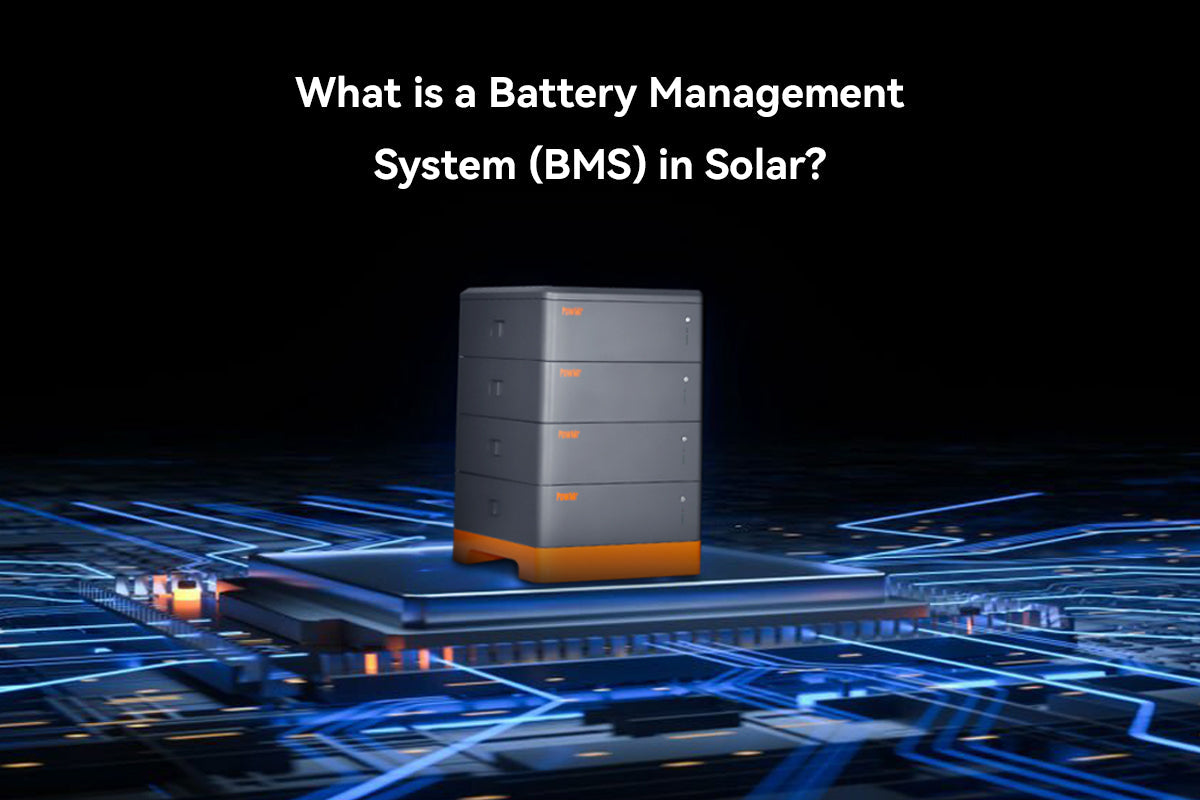ในภูมิทัศน์ที่เปลี่ยนแปลงตลอดเวลาของระบบพลังงานแสงอาทิตย์ ระบบจัดการแบตเตอรี่ (BMS) มีบทบาทสำคัญในการรับประกันประสิทธิภาพ อายุการใช้งาน และความปลอดภัย.
คู่มือนี้เจาะลึกถึงบทบาทสำคัญของ BMS ในการใช้งานพลังงานแสงอาทิตย์ อธิบาย ฟังก์ชัน ของมัน เสนอ ข้อมูลเชิงลึกที่สำคัญสำหรับการเลือก BMS ที่เหมาะสมที่สุดสำหรับระบบพลังงานแสงอาทิตย์ของคุณ และแนะนำ แบตเตอรี่ LiFePO4 แบบซ้อนที่ยอดเยี่ยมพร้อม BMS.
- ทำไมถึงต้องมีระบบจัดการแบตเตอรี่?
- ระบบจัดการแบตเตอรี่คืออะไร
- ระบบจัดการแบตเตอรี่ทำอะไรในพลังงานแสงอาทิตย์?
- วิธีการเลือก BMS สำหรับแบตเตอรี่ของคุณ?
- การรวมระบบ BMS ในพลังงานแสงอาทิตย์ - PowMr แบตเตอรี่ LiFePO4 แบบซ้อนรุ่น POW-LIO51400-16S
- คู่มือวิดีโอเกี่ยวกับวิธีที่ BMS มีปฏิสัมพันธ์กับอินเวอร์เตอร์โซลาร์เซลล์
ระบบจัดการแบตเตอรี่คืออะไร
ระบบจัดการแบตเตอรี่ (BMS) เป็น อุปกรณ์ที่สำคัญในการตรวจสอบ, ควบคุม, และปกป้อง แบตเตอรี่แบบชาร์จไฟได้ มันจัดการเซลล์แต่ละเซลล์ภายในแบตเตอรี่เพื่อให้มั่นใจในประสิทธิภาพที่ดีที่สุดและอายุการใช้งานที่ยาวนาน.
BMS สามารถเป็นภายใน, รวมอยู่ในแบตเตอรี่แพ็ค, หรือภายนอก, แยกจากแพ็ค BMS ภายในเป็นที่นิยมในอุปกรณ์อิเล็กทรอนิกส์สำหรับผู้บริโภค ในขณะที่ BMS ภายนอกใช้ในรถยนต์ไฟฟ้าและระบบจัดเก็บพลังงานขนาดใหญ่ ทั้งสองประเภทมีบทบาทสำคัญในการเพิ่มอายุการใช้งานของแบตเตอรี่ ป้องกันการชาร์จเกิน การปรับสมดุลเซลล์ และป้องกันการร้อนเกินไปหรือการปล่อยพลังงานมากเกินไป.
ทำไมถึงต้องมีระบบจัดการแบตเตอรี่?
ในภูมิทัศน์ที่เปลี่ยนแปลงอย่างรวดเร็วของการใช้พลังงานแสงอาทิตย์ ระบบจัดการแบตเตอรี่ (BMS) โผล่ขึ้นมาเป็นผู้เล่นที่สำคัญ โดยทำหน้าที่ประสานความกลมกลืนภายในระบบพลังงานแสงอาทิตย์ ฟังก์ชันของมันขยายออกไปเกินกว่าการดูแลทั่วไป โดยเจาะลึกไปยังขอบเขตของ การป้องกัน, การตรวจสอบ, และการสื่อสาร.
การป้องกันแบตเตอรี่
ฟังก์ชันหลักของ BMS คือการปกป้องแบตเตอรี่ มันป้องกันการชาร์จเกินและการปล่อยเกิน ทำให้แน่ใจว่าแบตเตอรี่ทำงานภายในพารามิเตอร์ที่เหมาะสม กลไกการป้องกันนี้มีความสำคัญต่อ การขยายอายุการใช้งานของแบตเตอรี่และรักษาประสิทธิภาพของมัน ตลอดเวลา.
การตรวจสอบแบตเตอรี่
BMS จะตรวจสอบสัญญาณสำคัญของแบตเตอรี่ เช่น แรงดันไฟฟ้า กระแสไฟฟ้า และอุณหภูมิอย่างต่อเนื่อง การตรวจสอบแบบเรียลไทม์นี้ช่วยให้ผู้ใช้ทราบเกี่ยวกับสภาพของแบตเตอรี่ ทำให้สามารถดำเนินการเชิงรุกในกรณีที่มีความผิดปกติ โดย การให้ข้อมูลที่สำคัญ BMS จะช่วยให้ผู้ใช้สามารถตัดสินใจได้อย่างมีข้อมูลเกี่ยวกับระบบพลังงานแสงอาทิตย์ของตน.
การสื่อสาร
การอำนวยความสะดวกในการสื่อสารระหว่างส่วนประกอบเป็นอีกหนึ่งบทบาทสำคัญของ BMS มันช่วยให้เกิด การมีปฏิสัมพันธ์ที่ราบรื่นระหว่างแบตเตอรี่ แผงโซลาร์เซลล์ และส่วนประกอบอื่น ๆ ของระบบ ความสามารถในการสื่อสารนี้ช่วยเพิ่มประสิทธิภาพโดยรวมของระบบพลังงานแสงอาทิตย์โดยการเพิ่มประสิทธิภาพการไหลและการกระจายพลังงาน.
ระบบจัดการแบตเตอรี่ทำอะไรในพลังงานแสงอาทิตย์?
เพื่อให้เข้าใจบทบาทของระบบจัดการแบตเตอรี่ในแอปพลิเคชันพลังงานแสงอาทิตย์ จำเป็นต้องเจาะลึกลงไปในฟังก์ชันเฉพาะของมัน
ฟังก์ชันการป้องกัน
-
การป้องกันแรงดันไฟฟ้า
BMS ปกป้องแบตเตอรี่โดยการป้องกันไม่ให้แรงดันไฟฟ้าเกินขีดจำกัดที่ปลอดภัย ลดความเสี่ยงของความเสียหาย. -
การป้องกันกระแสไฟฟ้า
มันตรวจสอบและควบคุมกระแสไฟฟ้าที่ไหลเข้าและออกจากแบตเตอรี่ ป้องกันปัญหาต่าง ๆ เช่น การชาร์จเกินหรือการปล่อยไฟฟ้ามากเกินไป. -
การป้องกันการชาร์จเกินและการปล่อยเกิน
BMS ป้องกันไม่ให้แบตเตอรี่ถูกชาร์จเกินหรือปล่อยเกิน ทำให้รักษาสภาพการทำงานที่เหมาะสม -
การป้องกันลัดวงจร
การป้องกันการลัดวงจรเป็นฟีเจอร์ด้านความปลอดภัยที่สำคัญ ช่วยป้องกันอันตรายที่อาจเกิดขึ้น
การสมดุลแบตเตอรี่
โดยการจัดการและ ปรับสมดุลแรงดันไฟฟ้าของแบตเตอรี่แต่ละก้อน เพื่อให้แน่ใจว่าสุขภาพและประสิทธิภาพโดยรวมของแบตเตอรี่แบงค์อยู่ในระดับดี BMS ช่วยเพิ่มประสิทธิภาพและอายุการใช้งานของระบบแบตเตอรี่ทั้งหมดให้สูงสุด ซึ่งทำให้แน่ใจว่าการจัดเก็บพลังงานทำงานได้อย่างเหมาะสม ส่งมอบประสิทธิภาพที่เชื่อถือได้และยั่งยืนในระยะเวลาที่ยาวนาน.
การจัดการสถานะการชาร์จ (SoC)
BMS กำหนดได้อย่างแม่นยำว่า
การควบคุมอุณหภูมิ
การตรวจสอบและควบคุมอุณหภูมิของเซลล์แบตเตอรี่เป็นฟังก์ชันที่สำคัญของ BMS โดย การป้องกันสภาวะอุณหภูมิที่รุนแรง BMS จะปกป้องแบตเตอรี่จากความเสียหายและการเสื่อมสภาพที่อาจเกิดขึ้น
การตรวจจับข้อผิดพลาดและการวินิจฉัย
BMS จะ ตรวจสอบแบตเตอรี่ตลอดเวลาเพื่อหาข้อผิดพลาดหรือความผิดปกติ ในกรณีที่เกิดความผิดปกติ BMS สามารถ แยกส่วนที่มีปัญหาออก เพื่อป้องกันไม่ให้ระบบทั้งหมดถูกทำลาย นอกจากนี้ยังมีข้อมูลวินิจฉัยที่ช่วยในการแก้ไขปัญหาและการบำรุงรักษา
การบันทึกข้อมูลและการรายงาน
BMS จะบันทึกข้อมูลเกี่ยวกับตัวชี้วัดประสิทธิภาพหลักและเหตุการณ์ต่าง ๆ ซึ่งให้บันทึกประวัติพฤติกรรมของแบตเตอรี่ ข้อมูลนี้มีค่าในการวิเคราะห์แนวโน้มระยะยาว การระบุรูปแบบ และการตัดสินใจอย่างมีข้อมูลเกี่ยวกับการปรับแต่งระบบ
วิธีการเลือก BMS สำหรับแบตเตอรี่ของคุณ?
การเลือกระบบจัดการแบตเตอรี่ที่เหมาะสมเป็นสิ่งสำคัญสำหรับการเพิ่มประสิทธิภาพและอายุการใช้งานของระบบพลังงานแสงอาทิตย์ของคุณ นี่คือข้อพิจารณาที่สำคัญที่ควรคำนึงถึง
ความเข้ากันได้ของเคมีแบตเตอรี่
ตรวจสอบให้แน่ใจว่า BMS เข้ากันได้กับ เคมีแบตเตอรี่เฉพาะ ที่ใช้ในระบบพลังงานแสงอาทิตย์ของคุณ ไม่ว่าจะเป็นลิเธียมไอออนหรือ LiFePO4 การเลือก BMS ที่สอดคล้องกับประเภทแบตเตอรี่ของคุณเป็นสิ่งสำคัญสำหรับประสิทธิภาพที่ดีที่สุด.
ความสามารถในการปรับขนาด
พิจารณาความสามารถในการขยายตัวของ BMS เมื่อระบบพลังงานแสงอาทิตย์ของคุณเติบโต BMS ควรมีความสามารถในการ รองรับความจุของแบตเตอรี่ ความสามารถในการขยายตัวช่วยให้มีความยืดหยุ่นและป้องกันอนาคตสำหรับการขยายที่อาจเกิดขึ้น
โปรโตคอลการสื่อสาร
BMS และอินเวอร์เตอร์โซลาร์สื่อสารกันโดยใช้ โปรโตคอลการสื่อสารมาตรฐาน เช่น Modbus หรือ CAN (Controller Area Network) โปรโตคอลเหล่านี้ช่วยให้การแลกเปลี่ยนข้อมูลที่สำคัญเป็นไปได้ ทำให้อินเวอร์เตอร์โซลาร์สามารถปรับการทำงานตามสถานะจริงของแบตเตอรี่ได้.
ตรวจสอบว่า BMS รองรับโปรโตคอลการสื่อสารที่เข้ากันได้กับอินเวอร์เตอร์โซลาร์ของคุณหรือไม่ ความเข้ากันได้กับโปรโตคอลมาตรฐานในอุตสาหกรรมช่วยให้การสื่อสารระหว่างส่วนประกอบเป็นไปอย่างราบรื่น เพิ่มประสิทธิภาพของระบบโดยรวม.
แรงดันไฟฟ้าและกระแสไฟ
กำหนดแรงดันไฟฟ้าและกระแสสูงสุดที่ BMS รองรับ ข้อมูลนี้มีความสำคัญต่อการรับรองว่า BMS สามารถจัดการกับความต้องการเฉพาะของแบตเตอรี่โซลาร์ของคุณได้ ป้องกันการโหลดเกินและความล้มเหลวของระบบที่อาจเกิดขึ้น.
การรวมระบบ BMS ในพลังงานแสงอาทิตย์ - PowMr แบตเตอรี่ LiFePO4 แบบซ้อนรุ่น POW-LIO51400-16S
จากการสร้างความสำคัญของปัจจัยที่กล่าวถึงข้างต้น PowMr POW-LIO51400-16S ถือเป็นตัวเลือกที่ยอดเยี่ยมสำหรับระบบจัดการแบตเตอรี่ในแอปพลิเคชันพลังงานแสงอาทิตย์.
-
ระบบจัดการแบตเตอรี่ LiFePO4 แบบรวม
PowMr POW-LIO51400-16S มาพร้อมกับ BMS LiFePO4 ที่รวมอยู่ในตัว ซึ่งรับประกันความเข้ากันได้และประสิทธิภาพที่ดีที่สุดสำหรับเคมีแบตเตอรี่ LiFePO4. -
ความสามารถในการปรับขนาด
ด้วยความจุ 51.2V 100Ah ต่อแบตเตอรี่ ระบบ PowMr รองรับ การสื่อสารแบบขนานได้สูงสุดถึง 16 แบตเตอรี่ ความสามารถในการขยายนี้ทำให้เป็นโซลูชันที่หลากหลายสำหรับความต้องการพลังงานที่แตกต่างกัน. -
การสื่อสารกับอินเวอร์เตอร์ของแบรนด์ส่วนใหญ่
PowMr POW-LIO51400-16S รองรับโปรโตคอลการสื่อสารที่เข้ากันได้กับแบรนด์อินเวอร์เตอร์ส่วนใหญ่ ซึ่งช่วยให้การสื่อสารและการประสานงานภายในระบบพลังงานแสงอาทิตย์เป็นไปอย่างราบรื่น.
| ยี่ห้ออินเวอร์เตอร์ | วิธีการสื่อสาร | ขาเชื่อมต่ออินเวอร์เตอร์ | ขั้วสื่อสารแบตเตอรี่ |
|---|---|---|---|
| PowMr | RS485 | พิน 7 : RS485A รหัส PIN8 : RS485B |
พิน2/7: RS485A ขา1/8 : RS485B |
| เอสเอ็มเอ | สามารถ | PIN4: วอร์ด PIN5 : แคนแอล |
PIN4: วอร์ด PIN5 : แคนแอล |
| วิคตรอน | สามารถ | PIN7: วอร์ด PIN8 : แคนแอล |
PIN4: วอร์ด PIN5 : แคนแอล |
| โกรวัตต์ | RS485 | พิน 7 : RS485A รหัส PIN8 : RS485B |
พิน2/7: RS485A ขา1/8 : RS485B |
| กู๊ดเว | สามารถ |
PIN4: วอร์ด PIN5 : แคนแอล |
PIN4: วอร์ด PIN5 : แคนแอล |
| ไพลอนเทค | RS485 | พิน 7 : RS485A พิน 8: RS485B |
พิน2/7: RS485A ขา1/8 : RS485B |
| ลักซ์พาวเวอร์ | RS485 | พิน 2 RS485A ขา 1 RS485B |
พิน2/7: RS485A ขา1/8 : RS485B |
| โวลโทรนิคพาวเวอร์ | RS485 | พิน 5 RS485A ขาที่ 3 : RS485B |
พิน2/7: RS485A ขา1/8 : RS485B |
| โซฟาร์ | สามารถ | PIN1: ดู PIN2 : ถ่ายทอดสด |
PIN4: วอร์ด PIN5 : แคนแอล |
| กวาง | RS485 | พิน 7 : RS485A รหัส PIN8 : RS485B |
พิน2/7: RS485A ขา1/8 : RS485B |
| พูด | RS485 สามารถ |
PIN4: วอร์ด พิน : CANL |
PIN4: วอร์ด PIN5 : แคนแอล |
| เมกาเรโว | สามารถ | PIN4: วอร์ด PIN5 : แคนแอล |
PIN4: วอร์ด PIN5 : แคนแอล |
| ต้อง | สามารถ | PIN4: วอร์ด PIN5 : แคนแอล |
PIN4: วอร์ด PIN5 : แคนแอล |
เคล็ดลับ: แบตเตอรี่ตัวนี้และแบตเตอรี่แรงดันสูงอีกตัวหนึ่งบนเว็บไซต์ของเรา สามารถสั่งจองล่วงหน้าได้ทั้งคู่ หากต้องการข้อมูลเพิ่มเติม สามารถติดต่อเราได้เลย.



